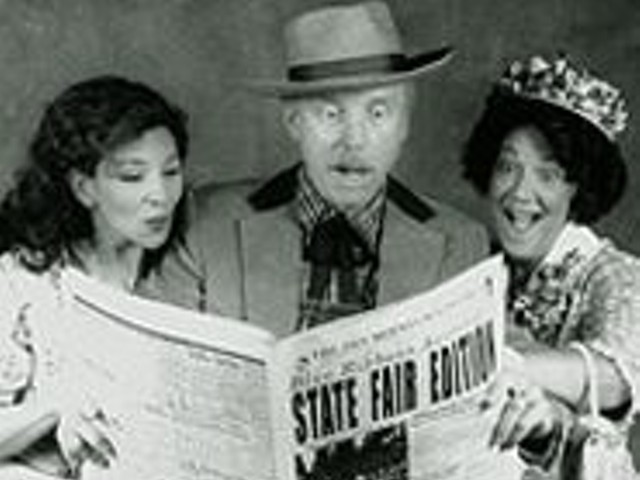The sound of the revved-up engine is so concussive it necessitates earplugs, which sell briskly at trackside. The specially cooked up nitromethane fuel is sufficiently noxious that yellow clouds of exhaust fumes make fans cry.
A driver swaddled in fireproof uniform and helmet is strapped solidly into a tiny cockpit. When the Christmas tree of staging lights goes green, he floors it, and it's all he can do to keep the thing going in a straight line. In less than five seconds it is over. The drivers have topped 300 mph in the quarter-mile and released a parachute or two to slow the car down.
It's absurd, isn't it, so much power and so much speed over so short a distance, in a caricature of an automobile, seemingly cribbed from the "Rat Fink" fantasy illustrations of hot rodder Ed "Big Daddy" Roth. The refined attributes of the modern top-fuel dragster are a wonder to behold, and once a year St. Louisans are privileged to inhale the poison fumes at the Sears Craftsman Nationals, the National Hot Rod Association event at Gateway International Raceway in Madison, Ill.
The Craftsman Nationals, like the other 23 events in the yearly NHRA Winston Cup schedule, feature drag competition in other classes as well, including funny car, pro stock car, pro stock truck and pro stock motorcycle. There is also a generous range of what are called Federal-Mogul or sportsman classes, involving other designated types of vehicles.
The funny cars are just awesome, sitting at an extreme wedge angle to the ground and each boasting a blower that seems to have busted through the hood in front of the windshield. The pro stock cars and trucks appeal to the fans who like a somewhat more realistic machine, with more steel in the shell and more factory parts. The pro stock bike is a whole 'nother animal, with its humongous rear tire and the driver lying flat across the seat.
Before the dragsters race, they must burn out. Almost as popular as the race itself, the burnout is when the drivers spin their tires at high rpms in water put down on the track. This heats and cleans the tires just before the run, enhancing traction, and releases thick white clouds of steam.
Fans will enjoy nighttime racing at Gateway, when the fire from the exhaust pipes seems more dramatic and the sun isn't baking down on the cars and the track, causing problems that lead to slower speeds. Fans will also enjoy something that only the NHRA offers: the chance to walk right up to the pits for a close-up view of the cars and to talk with the crews.
You may even get to chat with a driver, like fan favorite Kenny Bernstein, the Bud King, who has captured a Winston crown in both the top-fuel and funny-car divisions and was the first man to crack 300 mph in the sport. Or Cristen Powell, the 21-year-old phenom who drives that gorgeous white-fading-to-purple Pontiac funny car. The NHRA changed their rulebook to allow the prodigy to compete when she was just 17. If you're lucky, you may catch the eye of John Force, ageless dominator of the funny-car circuit, or one of the four Coughlin brothers, who race pro stock car and truck.
The dominant top-fuelers include Gary Scelzi and Tony Schumacher. Scelzi was the Winston points champion in 1997 and '98 and captured the last two Gateway championships. But these days he's also the focus of attention for a spectacular crash several races ago that left him upside down with his car on fire.
"If there is such a thing as a safe feeling, it's when you shut the dragster down," he says. "You pull the parachutes and you start to decelerate; it's pretty comforting when the parachutes hit. In that case, the parachutes hadn't hit yet. I had just pushed the button, hit the fuel shut-offs, and the car went into a violent vibration. At that time, the tire came apart and took the rear wing off and then I was upside down and on my side, but when it started to vibrate I completely lost my vision. When my vision came back, I was on my side sliding across the racetrack looking for Tony (Schumacher, his opponent) ... you have no brakes ... sliding backwards conscious not knowing what you're going to hit from behind -- that wasn't a good feeling."
The boyishly 30-year-old Schumacher was the 1999 Winston top-fuel champion and is the fastest driver in NHRA history, with a run of more than 330 mph. The sudden success of his first full year of competition left many incredulous and the young driver defiant. "That's what was so much fun about people saying, 'Well, it's his first year -- maybe he didn't deserve it,'" recalls Schumacher. "Let me tell you something -- you deserve it when you win. If you want the championship, come take it, man -- I'll be there. I'll be sitting there in the other lane. Come get it. Here it is."
Fenton's Jerry Haas builds pro stock car and truck chassis for a good chunk of NHRA drivers and sponsors a pro stock truck racer. He has also won his share of titles as a dragger. "Every driver will say the same thing," he says. "You can never go fast enough."
Gateway International Raceway, 700 Raceway Blvd. in Madison, Ill., hosts the NHRA Sears Craftsman Nationals, June 22-24. Call 314-241-1888 for tickets.





